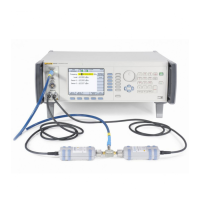96000 Series
Service Manual
4-10
Note
The next steps make the low-level flatness adjustment of the 50
Ω
Leveling Head using a Spectrum Analyzer/Measuring Receiver.
21. Set the UUT to OPER.
22. Set the Spectrum Analyzer reference level, span, resolution and/or video
bandwidth as necessary to make a high-quality level measurement at the
applied level and frequency.
Note.
For each frequency it is important to maintain consistent
analyzer/receiver settings as the target amplitude changes. For any
given frequency the Analyzer setting can be to suit, but that setting
must be maintained for all amplitudes at that frequency after the
transfer point. In particular, analyzer attenuator, reference level and
resolution bandwidth settings must not change. Typically there are 3
or 4 amplitudes per frequency point during which the Analyzer
settings must be static.
23. Using the blue arrow keys and rotary knob, edit the UUT Actual output until
the Spectrum Analyzer display indicates the Target value stated. Push
Accept Target.
24. Push Next Target.
25. Repeat steps 22 through 24 for all points requiring the use of the Spectrum
Analyzer until all Leveling Head adjustments are completed.
26. Push Back. The 50 Ω Leveling Head adjustment is now complete.
27. If additional Leveling Heads are to be adjusted, substitute the remaining
Leveling Head(s) for the one currently attached and perform the appropriate
(50 Ω or 75 Ω) Leveling Head adjustment process. If not, push
Exit>Back>Exit to return the UUT to a normal operating state.
Leveling Head Adjustment – 75
Ω
Equipment required:
• AC Measurement Standard
• Precision feedthrough termination, 75 Ω
• 75 Ω Type-N female-to-50 Ω Type-N male adapter
• Power Meter
• Power Sensor, 75 Ω
• Spectrum Analyzer/Measuring Receiver
• Precision Adapter, Type-N female-to-female, 75 Ω
• 75 Ω to 50 Ω impedance-matching pad
Note
Base Adjustment must be performed before attempting Head
adjustment. Once Base adjustment has been performed, Head
adjustment can take place in any order (50 or 75 first).

